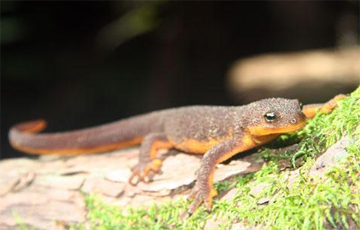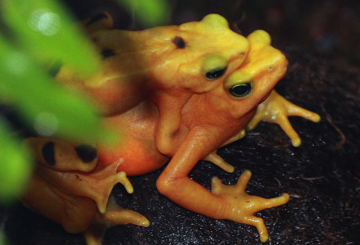Deer enhance biodiversity of reptiles and amphibians in forest areas
Ohio State University
October 21, 2008
The presence of deer affects the number of reptiles, amphibians and insects found in forest areas, suggests a new study by researchers at Ohio State University and National Park Service. A higher abundance of deer is associated with greater biodiversity.
|
|
Reducing the number of deer in forests and parks may unexpectedly reduce the number of reptiles, amphibians and insects in that area, new research suggests.
A recent study by researchers at Ohio State University and National Park Service found that higher deer activity is modifying forest ecosystems in unexpected ways. Out of several species of snakes, salamanders, and invertebrates studied, a greater diversity of animals were found in areas with deer populations than were in areas with no deer activity.
The study, which comes at a time when many states have begun to selectively control deer populations, challenges previous research that has suggested deer populations can negatively impact forest ecosystems through eating plants that many smaller animals may depend on.
Instead, researchers found that high numbers of deer may in fact be attracting a greater number of species. This may be because their waste creates a more nutrient-rich soil and as a result, areas with deer draw higher numbers of insects and other invertebrates. These insects then attract larger predators which thrive on insect lava such as salamanders, and the salamanders in turn attract even larger predators such as snakes.
 A friend of deer? |
The results, which were published recently in The Journal of Wildlife Management, highlight how recent attempts to control deer populations in and around forests may indirectly affect other animals in the forest.
“By just reducing the number of deer in the forest, we’re actually indirectly impacting forest ecosystems without even knowing the possible effects,” said Katherine Greenwald, co-author of the study and doctoral student in evolution, ecology, and organismal biology at Ohio State.
“Smaller creatures like salamanders and insects are all part of the base of a larger food web that can be affected by small changes.”
Research was conducted in Cuyahoga Valley National Park, a 51-square-mile park in northeastern Ohio with an estimated deer population of 2,300 to 4,600. The park’s large population of deer and varying landscape made it an ideal place to test for the effects of these animals, she said.
Researchers studied the forest by pairing 12 unfenced sites with 12 fenced sites, called exclosures, based on similar habitat type, forest cover, soil type, and slope. The exclosures, which are used frequently to test for differences in plant growth between grazed and untouched areas, prevent deer from grazing in certain areas. Both unfenced and fenced areas measured 10 meters by 10 meters (approximately 33 feet by 33 feet).
Five square wood boards measuring almost one square foot (30 centimeters square) were placed in random spots in each fenced and unfenced site. These boards are placed on top of the soil and act as rocks or other ground cover for salamanders, slugs and other animals to hide under for protection.
The researchers then counted the number of invertebrates and vertebrates under each board every three to four weeks from May through December in 2004 and monthly from May through September the following year.
They identified a variety of species during the study including snakes, salamanders, earthworms, slugs, spiders, ants, beetles, and many more invertebrates. Species diversity was determined by comparing the variety of insect groups and invertebrates found in each area.
The results, Greenwald said, were completely unexpected.
“We thought the salamanders especially would be very sensitive to areas with deer because in those areas the whole undergrowth is basically gone. So we thought these creatures were going to be much more abundant in the fenced exclosures because it is just bursting with plants and other studies have shown that amphibians prefer damp, covered areas,” she said.
Instead, they found that many of the species studied favored the unfenced areas where deer grazed frequently. Pill bugs, centipedes, millipedes, and beetles were found equally in grazed and fenced areas, but many other creatures were found in greater numbers in grazed areas.
Researchers found nearly three times as many red-backed salamanders and five-and-a-half times more snakes in sites with deer than those without deer. Among invertebrates, snails were 11 percent more abundant in grazed areas than in exclosures and the diversity of arthropods was also 14 percent greater in these areas.
Greenwald speculates that the areas with higher deer populations may appear to lack the high variety of low-lying plants found in exclosures, but the deer may be creating a richer soil mixture through their droppings. This rich soil may be benefiting some plants in the area, which in turn is attracting a larger diversity of insects and invertebrates.
Salamanders and snakes may then be following these creatures, creating a more diverse animal population overall in areas with deer.
“Another possibility is that we are observing a ‘refuge effect,’ where animals in the grazed areas are more likely to use the cover objects than animals in the ungrazed areas. If the ground in the exclosures really is more favorable, as we originally thought, maybe the animals there just have no need for our artificial cover boards,” Greenwald said.
But no matter what the reason, she cautions that the take-home message of the study is that officials need to understand the forest ecosystem before making decisions about wildlife management.
“We need to be aware of what’s happening in these forest ecosystems. Culling deer may cascade into affecting plants, salamanders, and other creatures in ways we can’t even imagine. So before we start removing deer we should study what’s really happening in these areas because there are a whole host of other issues that go along with culling,” she said.
Greenwald conducted the study with Thomas Waite, former associate professor of evolution, ecology and organismal biology at Ohio State, and Lisa Petit of the Cuyahoga Valley National Park.
 A casualty of chytrid? Panama’s golden frog (Atelopus zetecki), a species that may now be extinct in the wild due to Chytridiomycosis. In many parts of Panama this frog — actually a species of harlequin toad — is considered a good luck charm and was once collected from the wild by people to put in their homes. Panama golden frogs mating in captivity. Photo by Rhett A. Butler |
The researchers also demonstrated declines in populations of frog-predators, like snakes. Other studies in Central America have also shown significant changes in the species composition of habitats following the disappearance of frogs.
The chytrid fungus is decimating amphibians populations around the world. While the drivers of its emergence and spread are hotly debated — climate change and spread by accidental human introduction of the pathogen to habitats are the leading theories — the disease kills up to 90 percent of amphibians when it enters an ecosystem. The extinction of more than 100 species of amphibian have been linked to the pathogen over the past 20 years and scientists are taking urgent measures to save the most affected species via ex-situ (i.e. captive breeding) conservation programs.
“Once the frogs die, it’s like an incredible silence descends over the whole area,” said Pringle, referring to the streams the researchers are monitoring. “It’s eerie.”
“The one speck of hope is that if we’re able to collect some of these rare animals, we can cure them,” added Connelly. “As long as we have the money to keep a breeding program going, in the future it might be possible to reintroduce them into the wild.”
Conservationists aim to raise more than $400 million by 2012 to help save endangered amphibians and their habitats. One project, the Amphibian Ark, seeks to establish captive breeding programs for the 500 species that are most at risk. Overall about one third the world’s 6,100 species of amphibians are threatened with extinction.
RELATED ARTICLES
Armageddon for amphibians? Frog-killing disease jumps Panama Canal October 12, 2008
Chytridiomycosis — a fungal disease that is wiping out amphibians around the world — has jumped across the Panama Canal, report scientists writing in the journal EcoHealth. The news is a worrying development for Panama’s rich biodiversity of amphibians east of the canal.